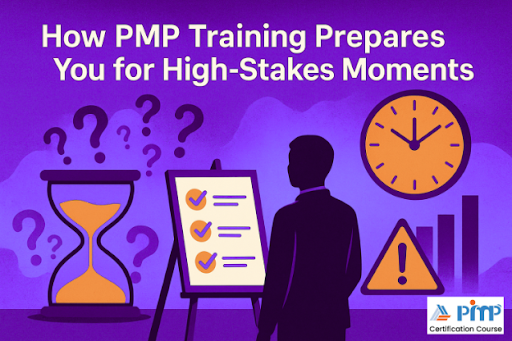
What separates a project manager who freezes under pressure from one who calmly turns chaos into control? It’s not just experience. It’s preparation. The kind that builds confidence when the room is tense, the deadlines are tight, and there’s no margin for error.
That’s where PMP Training proves its worth. You learn not just how to manage projects but how to lead through pressure with precision. And if you’ve ever debated PMP vs PRINCE2, you’ll see why so many professionals choose PMP when performance matters most. Let’s explore how this training gets you ready for the moments that matter most.
Table of Contents
- Core Competencies PMP Training Builds for High-Stakes Projects
- Conclusion
Core Competencies PMP Training Builds for High-Stakes Projects
PMP training is more than just theory, it builds real, situational strengths that come alive when things get tough. Below are the key competencies that help you lead confidently when the pressure is high:
Understanding What’s at Stake in Project Management
Stakes in any major enterprise are great. Tight budgets, rigorous customer expectations, and even little delays can cause major problems. One mistake may compromise not just deadlines but also business reputation and stakeholder confidence. Training in PMP helps you fully grasp organizational impact, stakeholder dynamics, and project constraints. It helps you to understand how every decision impacts results.
Developing Crisis-Ready Decision-Making
Usually, pressure impairs judgment. When something unanticipated throws off your well-considered plans, your capacity for fast, wise decisions becomes rather valuable. PMP training teaches you to think in analytical ways. Simulated situations and real-world case studies help you to learn to dissect issues, evaluate choices impartially, and act deliberately. Even in cases when the stakes are great, you are taught to avoid bad decisions. Rather, you develop a calm attitude that wins people over in trying circumstances.
Mastering the Tools That Bring Clarity Under Pressure
Together, these three project management tools and frameworks give visibility and control when projects get complex:
- Work Breakdown Structure (WBS): Having a clear outline of the project helps you rapidly isolate issues when they develop. WBS allows you to identify which tasks are dependent on one another, which milestones are at risk, and where small changes can be made without affecting the overall picture.
- Critical Path Method (CPM): CPM is necessary when time is running out. It clarifies which activities are time-sensitive and which have flexibility. During a crunch, this prioritizing helps you concentrate your efforts on where they are most needed.
- Earned Value Management (EVM): EVM enables you to compare performance against time, cost, and scope. These metrics enable you to demonstrate where the project stands using data. PMP training ensures that you are proficient in using these tools in real time.
Strengthening Leadership in Unpredictable Situations
Leadership is about action amid uncertainty. Situational leadership, developed through PMP training, allows you to adjust your approach according to the level of difficulty. PMP ideas direct your approach whether you have to inspire a demotivated workforce, settle a dispute, or comfort stakeholders following a setback.
Enhancing Team Communication and Alignment
Under pressure, communication gaps tend to widen. A missing update or unclear direction can cause the whole project to fall apart. Stakeholder management and communication planning receive significant emphasis in PMP training. Using the correct channels, you are learning how to create the appropriate message for the correct audience. This implies that everyone knows who is in charge, what is changing, and what to do while going through a crisis.
Building Risk Awareness and Management
Many project problems result from undiscovered or undervalued risks. PMP training teaches a proactive approach to risk management. Before a problem gets critical, you learn how to create risk registers, do extensive risk analyses, and create response strategies. This kind of insight is priceless. It ensures that you are not always reacting but rather equipped to manage curveballs. You are already implementing a plan while others scramble.
Conclusion
PMP training prepares you for the times when your ability and judgment will be most tested. It keeps you focused in high-stakes situations, utilizing structure and insight to propel results. Consider PMP Training to deepen your readiness for critical project challenges and build lasting project leadership skills.

